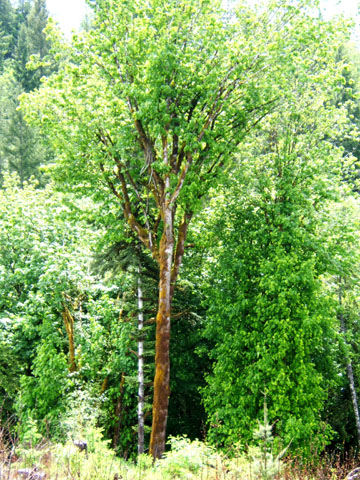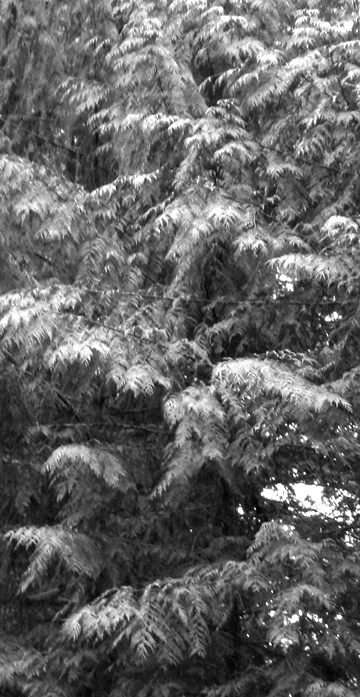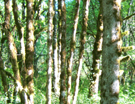Seeding the future: Tree farmers are turning to majestic redwoods for long-term investments
By Diane Dietz, The Register-Guard, November 15, 2009 [here]
Imagine the Coast Range around Noti and Veneta becoming the land of the giant coastal redwood — the tallest tree on earth, the one you can drive your car through.
Some tree farmers are doing more than imagining. They’re planting at least 20,000 coastal redwood trees a year in Lane and Douglas counties, according to the Cottage Grove seedling grower Plum Creek.
They’re driven less by fancy, or the awe the big trees inspire in many people, than by what they see as the best return on their investment in 30 or 40 years, when the trees are harvested.
Coastal redwoods put on volume three or four times as fast as Douglas fir, said Doug Wolf, a Douglas County forester. They can produce a “phenomenal” 5,000 board feet per acre per year. Plant them in blackberries, they shoot up through the fir-killing shade. Cut one down, and the stump will sprout a half dozen new trees. Let a deer or elk eat the tender tops, it can still grow up to 350 feet tall.
“They are quite the rejuvenator,” forester Dick Rohl said. “If you got any mass there, they’ll just take off like the dickens.”
“Like a weed practically,” Wolf added.
But the most compelling fact for those tree farmers planting coastal redwoods this year: Redwood logs are selling for $800 to $1,300 per thousand board feet compared with less than $250 for Douglas fir, according to Random Lengths, a wood products trade publication based in Eugene.
The Lane and Douglas tree farmers planting coastal redwood are betting that time will only widen that price gap.
Chapter 4: The Best Hardwoods
From A Guide to Innovative Tree Farming in the Pacific Northwest by Mike Dubrasich. 2005. Whirlwind Press. For a hard copy of the book ($10 - includes shipping) please contact W.I.S.E. [here].

Best of the Best: Bigleaf Maple (Acer macrophyllum)
Runners-Up: Oregon Ash (Fraxinus latifolia), Bitter Cherry (Prunus emarginata)
Honorable Mention: Red Alder (Alnus rubra)
Innovative tree farmers do not limit themselves to growing conifers only; hardwood tree species are too profitable not to grow. In fact, hardwoods can be much more profitable than conifers.
Hardwoods are more properly termed broad-leaved, flowering trees. Most hardwood trees native to the Pacific Northwest are deciduous; in contrast, most of our conifers are evergreens. The wood from hardwood trees is not necessarily hard, but hardwood wood does have a slightly different cellular structure than conifer wood.
Bigleaf maple
Of the hundreds of native hardwood tree species, bigleaf maple is the best of the best to grow on Pacific Northwest tree farms. It’s very fast-growing, easy to grow, produces multiple high-value products starting at a young age, and provides opportunities to add value.
Chapter 3: The Best Conifers
From A Guide to Innovative Tree Farming in the Pacific Northwest by Mike Dubrasich. 2005. Whirlwind Press. For a hard copy of the book ($10 - includes shipping) please contact W.I.S.E. [here].

Best of the Best: Western Red Cedar (Thuja plicata)
Runners-Up: Alaska Yellow Cedar (Chamaecyparis nootkatensis), Redwood (Sequoia sempervirens)
Honorable Mention: Noble fir (Abies procera)
There are thousands of native plant species in the Pacific Northwest. Hundreds have some commercial potential as tree farm crops. From these I have selected 15 species that I consider to be the best native plants for innovative tree farming. All 15 can economically out-perform Douglas-fir many times over. Innovative tree farmers are growing many more native species than these, but the 15 selected are the best, in my opinion.
I have divided the best species into four groups: conifers, hardwoods, shrubs, and herbaceous plants. Yes, shrubs and herbaceous plants; innovative tree farmers grow multiple species and harvest multiple products from every acre. From each group I have chosen the Best of the Best, the Runners-Up, and the Honorable Mentions. In this chapter I discuss the best conifers. In the next three chapters I discuss the best hardwoods, shrubs, and herbaceous plants.
Conifers are cone-bearing trees with naked seeds (pine nuts do not have shells). Conifers include pines, firs, cedars, cypresses, hemlocks, yews, larches, and Douglas-fir (Pseudotsuga menziesii). Conifers are also called softwoods, although the actual hardness of conifer wood varies greatly between species.
Western Red Cedar
Western red cedar is the best conifer species to grow on individual and family tree farms in the Pacific Northwest. Cedar produces multiple high-value products, starts producing income at a surprisingly young age, is easy to grow, and provides many opportunities to add value.
